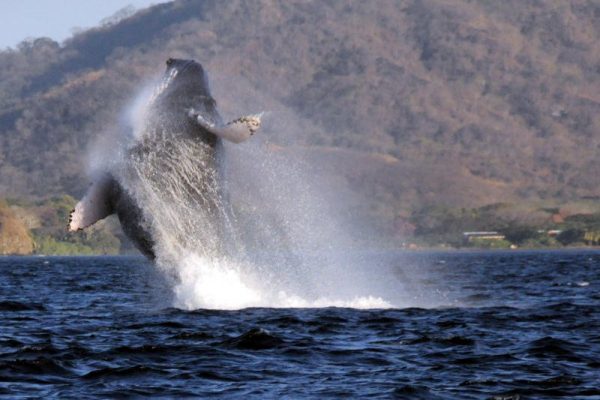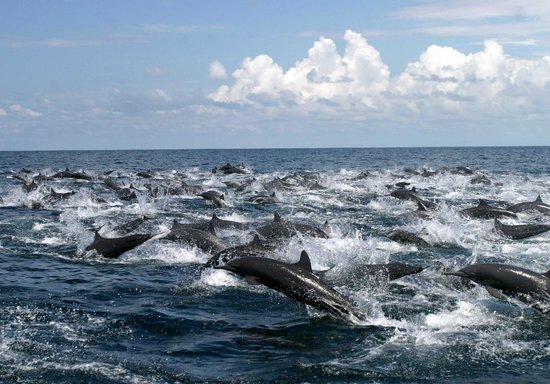Tuesday, August 20th, 2019.
In this Daily: Whales in Costa Rica, Around Town, and Beyond
In the past few weeks there has been a spike in whale sightings in Guanacaste waters, particularly sightings of humpback whales. Growing up to 50 feet, these giant creatures are a rare and beautiful sight in the warm, shallow seas beyond Las Catalinas, and recently there have been reports of sightings as close in as the Catalinas Islands and nearly to Bahía Potrero.
This comes as a result of the seasonal migrations of the humpbacks up from the Antarctic. This time of year, they venture thousands of miles to warmer tropical waters to give birth and raise their young. For the next few weeks, all along the Pacific coast there will be a greater chance to encounter these whales, which are generally docile and occasionally offer an unforgettable sight with their magnificent leaps from the water. This one, for example, was spotted a little more than a kilometer off shore of Playa Danta.

Spotting Whales Off of Las Catalinas | The Types of Whales in Costa Rica
There are nearly 25 species of cetacean that make the waters of Costa Rica their home, which are primarily toothed whales from the dolphin family. Bottlenose dolphins, common dolphins, pantropical spotted dolphins, Risso’s dolphins, rough-toothed dolphins, spinner dolphins, and striped dolphins make up the varietals of the more familiar members of this family, with orcas, false orcas, and short-finned pilot whales (also members of family Delphinidae) also appearing in Costa Rican waters.

These smaller, more agile whales typically travel in pods, which range from groups of a few individuals up to the superpods found off of the Osa Peninsula that can contain more than a thousand. Spottings can happen almost anywhere, as they have a wide range of habitats, and are usually seen briefly breaching the water with their dorsal fins as they travel through the waves.
The largest whales found in Costa Rican waters are the humpback whales, which can reach up to 50 feet long and weigh more than 30,000 kg. Typically only spotted between August-October and December-April when they are migrating through the area, humpbacks occasionally travel in pods but generally travel individually or with one calf.
Spotting Whales off of Las Catalinas | How to
The strategy for spotting whales in our region is different depending on which type of family you’re looking for. Dolphins are far more common, but can also be unpredictable. Due to their speed and agility in the water, they tend to outmaneuver any attempt to follow them, but occasionally come right up alongside boats under weigh to jump and play in the waves.
Humpbacks, on the other hand, can be spotted from kilometers away. Keeping an eye on the sea from shore, it’s possible to catch sight of the cresting white water. Many times, it’s just the breaking of waves, but as this story from a Las Catalinas homeowner shares, on rare occasions those crests are a telltale sign of these gentle giants.
"OK, I have no photos but I do have a story. My wife spotted a whale from the beach about 4:30 pm. It was about a mile out to sea. I ran up to the house, got my kayak, and headed out to see her. I did not see a thing until I was out past the Pitahaya islands. Then, I spotted her. Maybe a kilometer away. I got the heading and paddled. Closer and closer. Eventually I was paddling along right next to a full size (about 50 foot) humpback. I don't think she knew I was there. I was about 10 feet away. I could have easily paddled over and touched her. She was swimming lazily and took several huge breaths. Finally her head came up a bit, I and think maybe she saw me. Anyway, then her back arched up, her head went down, and she dived. And that was it. All this happened maybe a kilometer or so off of Punta Guachipelines."
In general, humpbacks are gentle and slow moving, so much so that they can be followed from kayaks and other small watercraft. However, there are a number of important protocols responsible powered vessel operators follow while observing these creatures, not to disturb them.
In smaller vessels, like kayaks or paddleboards, experts recommend using common sense for safety, as these peaceful creatures are still 30,000kg giants. While humpbacks are cruising along gently, it’s possible to get closer, but when when whales are breaching, they tend to do so more than once, so it’s much safer to retreat to a safe distance and watch.
Being in town offers a unique opportunity to get close to one of the world’s largest creatures under your own power.
Happy searching.